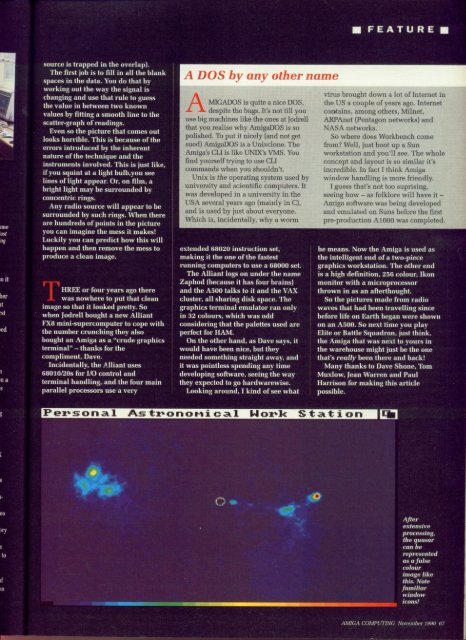Amiga Computing - Commodore Is Awesome
Amiga Computing - Commodore Is Awesome
Amiga Computing - Commodore Is Awesome
Create successful ePaper yourself
Turn your PDF publications into a flip-book with our unique Google optimized e-Paper software.
,m11<br />
-<br />
me<br />
ILO<br />
source is trapped in the overlap).<br />
The first job is to fill in all the blank<br />
spaces in the data. You do that by<br />
working out the way the signal is<br />
changing and use that rule to guess<br />
the value in between two known<br />
values by fitting a smooth line to the<br />
scatter-graph of readings.<br />
Even so the picture that comes out<br />
looks horrible. This is because of the<br />
errors introduced by the inherent<br />
nature of the technique and the<br />
instruments involved. This is just like,<br />
if you squint at a light bulb,you see<br />
lines of light appear. Or on film, a<br />
bright light may be surrounded by<br />
concentric rings.<br />
Any radio source will appear to be<br />
surrounded by such rings. When there<br />
are hundreds of points in the picture<br />
you can imagine the mess it makes!<br />
Luckily you can predict how this will<br />
happen and then remove the mess to<br />
produce a clean image.<br />
T was nowhere to put that clean<br />
Image H so that it looked pretty. So<br />
when R Jodrell bought a new Alliant<br />
FM E mini-supercomputer to cope with<br />
the E number crunching they also<br />
bought<br />
o<br />
an <strong>Amiga</strong> as a "crude graphics<br />
terminal" — thanks for the<br />
compliment, r Dave.<br />
f Incidentally, the Alliant uses<br />
68010120s o for I/O control and<br />
terminal u handling, and the four main<br />
parallel r processors use a very<br />
y<br />
e<br />
a<br />
r<br />
s<br />
a<br />
g<br />
o<br />
t<br />
h<br />
e<br />
r<br />
e<br />
A DOS by any other name<br />
A despite the bugs. It's not till you<br />
Muse<br />
big machines like the ones at Jodmil<br />
Ithat<br />
you realise why <strong>Amiga</strong>DOS is so<br />
Cpolished.<br />
To put it nicely (and not get<br />
Asued)<br />
<strong>Amiga</strong>DOS is a Unixclone. The<br />
D<strong>Amiga</strong>'s<br />
CLI is like UNIX's VMS. You<br />
Ofind<br />
yourself trying to use CLI<br />
S commands when you shouldn't.<br />
i Unix is the operating system used by<br />
s university and scientific computers. It<br />
qwas<br />
developed in a university in the<br />
u<br />
USA several years ago (mainly in C),<br />
i<br />
and is used by just about everyone.<br />
Which is, incidentally, why a worm<br />
t<br />
e<br />
a<br />
extended n 68020 instruction set,<br />
making i it the one of the fastest<br />
running c computers to use a 68000 set.<br />
e<br />
The Alliant logs on under the name<br />
Zaphod<br />
D<br />
(because it has four brains)<br />
and the A500 talks to it and the VAX<br />
O<br />
cluster, all sharing disk space. The<br />
S<br />
graphics terminal emulator ran only<br />
in . 32 colours, which was odd<br />
considering that the palettes used are<br />
perfect for HAM.<br />
On the other hand. as Dave says, it<br />
would have been nice, but they<br />
needed something straight away, and<br />
It was pointless spending any time<br />
developing software, seeing the way<br />
they expected to go hardwarewise.<br />
Looking around, I kind of see what<br />
Personal. As tronotli coil Work S tocti on<br />
• FEATURE •<br />
M<br />
virus brought down a lot of Internet i<br />
OPn the US a couple of years ago. Internet<br />
contains, among others, Milnet,<br />
ARPAnet (Pentagon networks) and<br />
NASA networks.<br />
So where does Workbench come<br />
from? Well, just boot up a Sun<br />
workstation and you'll see. The whole<br />
concept and layout is so similar it's<br />
incredible. In fact I think <strong>Amiga</strong><br />
window handling is more friendly.<br />
I guess that's not too suprising,<br />
seeing how — as folklore will have it —<br />
<strong>Amiga</strong> software was being developed<br />
and emulated on Suns before the first<br />
pre-production A1000 was completed.<br />
he means. Now the <strong>Amiga</strong> is used as<br />
the intelligent end of a two-piece<br />
graphics workstation. The other end<br />
is a high definition, 256 colour, Ikon<br />
monitor with a microprocessor<br />
thrown in as an afterthought.<br />
So the pictures made from radio<br />
waves that had been travelling since<br />
before life on Earth began were shown<br />
on an A500. So next time you play<br />
Elite or Battle Squadron, just think,<br />
the <strong>Amiga</strong> that was next to yours in<br />
the warehouse might just be the one<br />
that's really been there and back!<br />
Many thanks to Dave Shone, Tom<br />
Muxlow, Jean Warren and Paul<br />
Harrison for making this article<br />
possible.<br />
After<br />
extensive<br />
processing,<br />
the quasar<br />
can be<br />
represented<br />
as a false<br />
colour<br />
image like<br />
this. Note<br />
familiar<br />
window<br />
icons!<br />
AMIGA COMPUTING November 1990 67
















